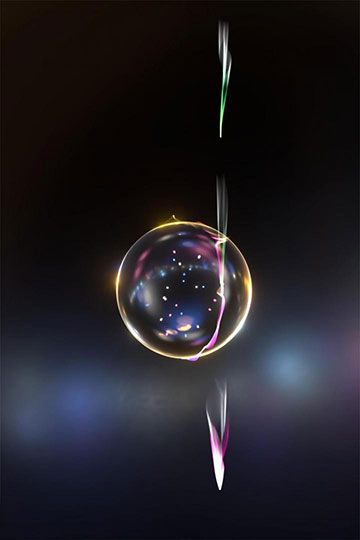
Artist’s view of individual electrons interacting with an optical whispering-gallery mode as it circles a silica sphere. [Credit: Murat Sivis]
Back in 1910, British physicist Lord Rayleigh published a mathematical solution to explain the famous whispering gallery in London’s St. Paul’s Cathedral. A whisper uttered at one end of the dome’s base could still be heard quite clearly at the opposite end, despite being over 100 feet away. He proposed that the sound waves cling to the wall’s curvilinear surface and travel tangentially along it.
Now, a team of researchers from the University of Göttingen, Germany, has leveraged an analogous effect seen in light to manipulate the beam of an electron microscope (Nature, doi: 10.1038/s41586-020-2320-y). Their technique of coupling free electrons to optical whispering-gallery modes, which are confined inside glass spheres due to total internal reflection, resulted in enhanced electron–photon coupling and opens the door for new applications in nanoscale sensing and microscopy.
A whispering-gallery mode resonator
Postdoctoral researcher Ofer Kfir and his colleagues in the Göttingen research group of Claus Ropers wanted to dramatically increase the electron–light interaction strength as a step towards quantum-optical observations with free electrons. They decided to explore dielectric resonators that support whispering gallery modes as a possible experimental approach. The hope was that, by passing the beam of electrons near the resonator, the two would exchange a sufficient amount of energy.
“Optical whispering-gallery modes have two advantages. First, these circulating modes can store light for some time, so we can use a laser to build up a stronger field,” said Kfir, the study’s first author. “Second, the interaction is extremely strong due to so-called phase matching—that is, the optical mode travels with a nearly perfect matching to the velocity of the electrons.”
Spectral broadening
The whispering-gallery-mode resonators in the experiment consisted of silica microspheres with diameters of 2 and 5 microns excited by optical pump pulses. An ultrafast transmission electron microscope with electron pulses as short as 200 femtoseconds passed near the surface of the microspheres. Phase matching resulted in the efficient transfer of energy and momentum, and the laser-driven whispering-gallery modes successfully stimulated gain and loss in the passing electrons.
As validation of the enhanced interaction, the researchers observed the emergence of an electron energy sideband of 700 electronvolts, which corresponds to the absorption and emission of hundreds of photons. The results suggest that whispering gallery-modes are a promising method for the coherent manipulation of free electrons that requires further exploration.
Individual quantum systems
The manipulation of the quantum state of the electron beam with light could lead to novel imaging and spectroscopy techniques that measure the optical properties of materials with atomic-scale resolution. The researchers wish to combine this with the study of extremely fast processes in matter, given that their lab is home to an electron microscope with the highest temporal resolution in the world.
“If you can enhance the coupling strength to be able to see the effect of a single photon on the electron, you can measure optical excitations on the level of individual quantum systems,” said Kfir. “Doing so with ultrafast temporal resolution and atomic-scale spatial resolution would be simply amazing—and highly relevant for technology, of course.”
